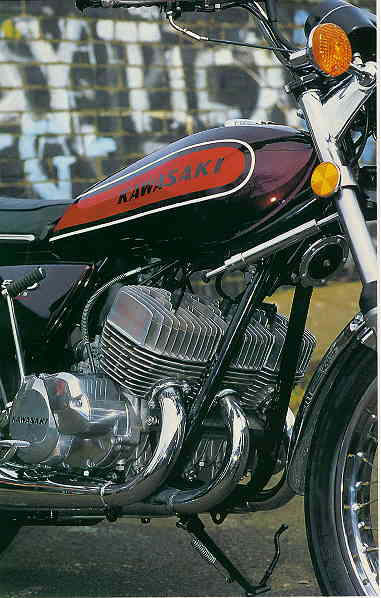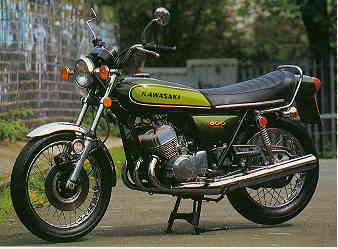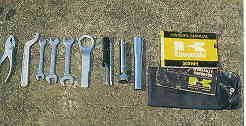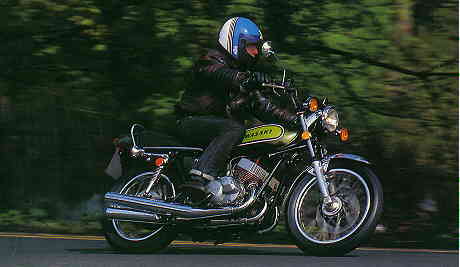
^ Back to Home Page ^
Period Roadtests
o

| Don't know if its because he is the third son of a third son, or if its because he was born on the third day of the third month but whatever it is, Steve Macualey definitely has a thing about Triples. Just so long as they carry the Kawasaki brand.
He's got garages, lofts and dining rooms full of them. Nearly finished ones, half built ones, ones inboxes and ones that make you want to take 'em home with you. The 1974 500cc H1E's here definitely belong in that category. Like many of the increasingly popular, firey two-strokes, Macualey's bikes are US imports. They arrived complete with owner histories, and one of them still had it's Texas plate fitted. US model specs differ only slightly from the ones that were sold here. The reflectors on the rear suspension units, the lack of a rear mudguard and the strapless seat are all giveaways of a US import. |
 |
Eagle eyes
will spot a seat strap on the red
bike - this was lifted from a
KH500 that briefly enjoyed
Macauley house space.
Steve was already very much a triplophile when he spotted a tiny classified ad from a Surrey bike shop that wanted to of- fioad two HIEs and a 750cc H2 they'd brought in from the States. "They weren't that easy to deal with," recalls Steve. "They wouldn't split the bikes; which I wanted them to do after a mate backed out of putting up a third of the asking price. So then I tried to do a deal because they were asking over the odds, but they wouldn't budge from that, either. "I still bought them, though." The one thing the dealer did do was to give the two 500s consecutive, age-related regis- tration numbers - hence the 1974 plates. The age of the H began in 1968 with the launch of the first H 1, probably better known to everybody as the Mach III - which stuck with all the varia- tions of the Hi throughout its lifespan. The combination of 60 peaky horses and a dry weight of just 3831bs guaranteed inter- esting handling characteristics. Part of the problem was the rearward bias of the weight dis- tribution: the rear wheel had to take 57 per cent of the dry weight, a fact that probably wasn't going though countless H1 pilots' minds as they head- ed hedgewards with an airborne front wheel... The H1 continued through 1969 and'70 with minor styling alterations, and became the H1A in 1971 with more styling tweaks and a new tank. The HIB of the following year featured much more radical chang es. The electronic ignition was junked in favour of contact breakers, new front forks were fitted, a hydraulic steering damper was added, a front disc brake appeared for the first time and the front mudguard was shortened. The HIC of '73 was short- lived. For this one, battery-pow- ered electronic ignition took over from points, then the HiD lifted the magneto electronic ignition system from the H2 750. The D's host of other chang- es included a slightly bigger petrol tank, a new seat (with a storage compartment in the tail), an endless drive chain and a return of the prodigal longer mudguard. At the end of all this, power had gone down by one measly h.orse, but dry weight had shot uo by 25lbs. |
 |
The H1E, Steve's bike, arrived in 1974 with a revised
chassis, a rubber-mounted en-
gine and yet another variation
on the electronic ignition theme.
Only colour changes identify the F model of 1975. The familiar KH prefix took over for the 500 triple's final year, 1976, but power had gone down further to 52bhp: still no slouch, but definitely lacking the appeal of the Mach III. Despite a pathological ob- session with the hairiest, smok- iest, thirstiest motor cycles ever invented, Steve Macauley had struck me as being a level-head- ed sort of bloke. Then he agreed to let me have a thrash on the very bike for which he'd just finished telling me an ever-in- creasing list of key spare parts are no longer available. |
| My opinion of his powers of judge-
ment went right out the win-
dow, but ! took the keys from
him just the same.
There's no ritual involved in starting -just turn on, give it a bit of (handlebar-mounted) choke if it needs it, swing down on the kickstart and prepare to be engulfed in lots of healthy smoke. The most surprising thing on pulling away (having re- membered the five-up gearshift pattern) is the smoothness, and although the vibes do build up as you press on a bit, I never found it to be a problem - even on the interesting side of the 6000rpm watershed. Even on the basis of a half hour ride, I thought the Kawasaki was a fascinating motorcycle. It was much more willing and forgiving out of its power- band than I had ever imagined it could be, although to be fair it should be said the Mach IIIs aren't quite the plug-oilers that biking folklore has sometimes implied. Even though this par ticular bike has never done the dirty on Steve, he still keeps three plugs under the seat, working on the notion that "you'd be daft not to." |
 |
The fuel consumption is just
as bad as you've probably heard,
though: don't expect to better
30mpg, and don't forget to check
the two-stroke oil tank, either.
Macauley recalls one run from Nottingham to his Merseyside base that necessitated five pet- rol stops. The upright riding position is just about ideal up to about the start of the really rather vicious powerband at 6k (80mph in top). From there on in, you have to make sure you're holding on tight. |
|
It was frustrating not to get
the chance to explore its top-
end potential, although I was
impressed by the way it just
sailed through 90mph, still go-
ing like the clappers. I hasten
to add this was on a good-qual-
ity A-road, away from the
bumps that are supposed to
bring to fruition its reputation
as "the triple with the ripple".
In fact, apart from a slight weave while accelerating hard though the gears, I didn't expe- rience any misbehaviour of the wobbly variety. I was being careful, though - honest, Steve. The single front disc is per- haps the one aspect of the bike's performance that dates it the most. It's spongy and lacks bite - I wouldn't relish having to rely on it for an emergency stop. In the wet, I guess it's just like all Japanese disc brakes of the mid-1970s (frightening). I wonder if many owners ever took advantage of Kawasaki's thoughtfulness in providing a lug for a second disc on the right-hand fork? I wonder how the 750 managed with the same brake? I (almost) look forward to finding out. Macauley's trio of triples arrived on the scene in April 1989, costing £3.450 the lot. "If I knew then what I know now I probably wouldn't have bought them - because they've cost me a lot of money. I reckon I've spent about four thousand on top of the purchase price, although most of that has gone on the H2C I'm rebuilding. Wait till you see that when it's finished - now that one will be special he said beaming. And from what I saw in the garage, it looks as though he's right. Watch this space. |
 |
The bulk of the spend with
the two 500s has gone on the
red one. "It was only running
on two cylinders, and had obvi-
ously been left standing for two
or three years, because all the
alloy was very badly tarnished,"
says Steve.
"It would have taken for ever and a day to clean up the engine casings, so I ended up fitting a new motor in it. In fact, the engine is the one that Kawasaki themselves used to train mechanics on. A dealer bought it from Kawasaki UK when they switched premises." Other new arrivals include a complete paintwork set of tank, sidepanels and tailpiece (there's a green spare set in the loft), together with new clocks, headlight brackets, cables, levers and a good set of tyres (Pirellis). The frame and swinging arm were powder-coated, and some rechroming work was carried out. |
|
The green bike, meanwhile,
wasn't all that bad to begin
with. Mirrors and indicators
were fitted, the pipes were rechromed and the tailpiece repainted. A new set of Pirellis completed a very nice picture.
Steve can't quite put his finger on why he likes the triples so much. "I've just always liked them, and the first bike I ever wanted was a Kawasaki 250. I had to settle for a Suzuki TS 100 on grandad's orders - he was paying for it - but I got the 250 eventually! "I find them very pleasing on the eye, too." Although all the triples have a bad reputation for all manner of things wearing out on them - ignition, pistons, crankcases - Steve's experience is that they'll provide many years happy motoring if they're looked after. "Another owner I know reck- ons that as long as you remember to change the rings regularly, they'll do many thousands of miles before they even need their first rebore." Otherwise, potential owners should be aware of the spares situation. Air boxes can't be had, except by joining the queue waiting for a good second-hand one to turn up; standard shocks are out; left-hand and centre exhaust pipes are okay, but forget the right-hand one. Steve Macauley's advice to anyone thinking of taking the plunge for an H1 is simp]y: "Make sure it's all there." Whether he was talking about the rider's brain or the bike is unclear. |
| SPECIFICATIONS ENGINE Three-cylinder, two-stroke, air- cooled. Borexstroke 60x58.8, 498.8cc. Com- pression ratio 6.8:1. CDI ignition. Maximum power 59bhp O 8000rpm, maximum torque 5.7 kg/m O 7000rpm TRANSMISSION CYCLE PARTS DIMENSIONS From Japanese Classics Magazine |